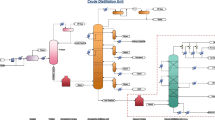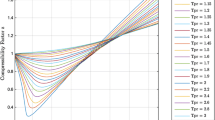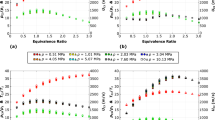Abstract
Aviation kerosene is commonly used in combustion and regenerative engine cooling processes in propulsion and power-generation systems, including rocket, scramjet, and advanced gas turbine engines. In this paper, many surrogate models proposed in the open literature are examined for their applicability and accuracy in calculating thermodynamic and transport properties of the China aviation kerosene RP-3 at supercritical pressures, based on the extended corresponding-states methods. The enthalpy change from endothermic decomposition and low heating value from combustion of the jet fuel are also evaluated. Results from a number of simple and representative surrogate models, which contain species components ranging from 1 to 10, are analyzed in detail. Data analyses indicate that a surrogate model with four species is the best choice for thermophysical property calculations under the tested conditions, with fluid temperature up to 650 K at various supercritical pressures. The surrogate model is particularly accurate in predicting the pseudo-critical temperature of aviation kerosene RP-3 at a supercritical pressure. A simple surrogate model containing the n-decane species and a surrogate model containing 10 species are the other two acceptable options. The work conducted herein is of practical importance for theoretical analyses and numerical simulations of various physicochemical processes at engine operating conditions.
Similar content being viewed by others
References
Palaszewski B, Ianovski L S, Carrick P. Propellant technologies: Far-reaching benefits for aeronautics and space-vehicle propulsion. J Propul Power, 1998, 14: 641–648
Edwards T. Liquid fuels and propellants for aerospace propulsion: 1993–2003. J Propul Power, 2003, 19: 1089–1107
Dagaut P, Cathonnet M. The ignition, oxidation, and combustion of kerosene: A review of experimental and kinetic modeling. Prog Energy Combust, 2006, 32: 48–92
Owens M G, Tehranian S, Segal C, et al. Flame-holding configuration for kerosene combustion in a mach 1.8 airflow. J Propul Power, 1998, 14: 456–461
Mawid M A, Park T W, Sekar B, et al. Development of detailed chemical kinetic mechanisms for ignition/oxidation of JP-8/Jet-A/JP-7 fuels. In: Proceedings of ASME Turbo Expo Atlanta, Georgia, USA, 2003
Fan X, Yu G, Li J, Zhang X. Investigation of vaporized kerosene injection and combustion in a supersonic model combustor. J Propul Power, 2006, 22: 103–110
Lenhert D B, Miller D L, Cernansky N P. The oxidation of JP-8, Jet-A, and their surrogates in the low and intermediate temperature regime at elevated pressures. Combust Sci Technol, 2007, 179: 845–861
Humer S, Seiser R, Seshadri K. Experimental investigation of combustion of jet fuels and surrogates in nonpremixed flows. J Propul Power, 2011, 27: 847–855
Huo H F, Yang V. Large eddy simulation of supercritical combustion of liquid oxygen and kerosene of a Bi-Swirl coaxial injector, AIAA Paper 2013-0429, 2013
Han C, Zhang P, Ye T H, et al. Numerical study of methane/air jet flame in vitiated co-flow using tabulated detailed chemistry. Sci China Tech Sci, 2014, 57: 1750–1760
Liu F Q, Zhang K Y, Liu C X, et al. Numerical and experimental investigation on emission performance of a fuel staged combustor. Sci China Tech Sci, 2014, 57: 1941–1949
Goel P, Boehman A L. Numerical simulation of jet fuel degradation in flow reactors. Energy Fuels, 2000, 14: 953–962
Zhong F, Fan X, Yu G, et al. Heat transfer of aviation kerosene at supercritical conditions. J Thermophys Heat Tr, 2009, 23: 543–550
Hua Y X, Wang Y Z, Meng H. A numerical study of supercritical forced convective heat transfer of n-heptane inside a horizontal miniature tube. J Supercrit Fluid, 2010, 52: 36–46
Bao W, Li X, Qin J, et al. Efficient utilization of heat sink of hydrocarbon fuel for regeneratively cooled scramjet. Appl Therm Eng, 2012, 33–34: 208–218
Jiang H, Ervin J, West Z, et al. Turbulent flow, heat transfer deterioration, and thermal oxidation of jet fuel. J Thermophys Heat Tr, 2013, 27: 668–678
Dang G X, Zhong F Q, Chen L H, et al. Numerical investigation on flow and convective heat transfer of aviation kerosene at supercritical conditions. Sci China Tech Sci, 2013, 56: 416–422
Ruan B, Meng H, Yang V. Simplification of pyrolytic reaction mechanism and turbulent heat transfer of n-decane at supercritical pressures. Int J Heat Mass Tran, 2014, 69: 455–463
Edwards T, Maurice L Q. Surrogate mixtures to represent complex aviation and rocket fuels. J Propul Power, 2001, 17: 461–466
Yang V. Modeling of supercritical vaporization, mixing, and combustion processes in liquid-fueled propulsion systems. P Combust Inst, 2000, 28: 925–942
Petit X. Ribert G, Lartigue G, et al. Large-eddy simulation of supercritical fluid injection. J Supercrit Fluid, 2013, 84: 61–73
Yu J, Meng H. A numerical study of counterflow diffusion flames of methane/air at various pressures. Sci China Tech Sci, 2014, 57: 615–624
Deng H W, Zhang C B, Xu G Q, et al. Density measurements of endothermic hydrocarbon fuel at sub- and supercritical conditions. J Chem Eng Data, 2011, 56: 2980–2986
Deng H W, Zhu K, Xu G Q, et al. Isobaric heat capacity measurement for kerosene RP-3 in the near-critical and supercritical regions. J Chem Eng Data, 2012, 57: 263–268
Deng H W, Zhang C B, Xu G Q, et al. Viscosity measurements of endothermic hydrocarbon fuel from (298 to 788 K) under supercritical pressure conditions. J Chem Eng Data, 2012, 57: 358–365
Wang N, Zhou J, Pan Y, et al. Determination of critical properties of endothermic hydrocarbon fuel RP-3 based on flow visualization. Int J Thermophys, 2014, 35: 13–18
Jiang R, Liu G Z, Zhang X. Thermal cracking of hydrocarbon aviation fuels in regenerative cooling microchannels. Energy Fuels, 2013, 27: 2563–2577
Huber M L, Ely J F. A predictive extended corresponding states model for pure and mixed refrigerants including an equation of state for R134a. Int J Refrig, 1994, 17: 18–31
Piazza L, Scalabrin G, Marchi P, et al. Enhancement of the extended corresponding states techniques for thermodynamic modeling I. Pure fluids. Int J Refrig, 2006, 29: 1182–1194
Scalabrin G, Marchi P, Bettio L, et al. Enhancement of the extended corresponding states techniques for thermodynamic modeling II. Mixtures. Int J Refrig, 2006, 29: 1195–1207
Ely J F, Hanley H J M. Prediction of transports properties 1. Viscosity of fluids and mixtures. Ind Eng Chem Fund, 1981, 20: 323–332
Ely J F, Hanley H J M. Prediction of transport properties 2. Thermal conductivity of pure fluids and mixtures. Ind Eng Chem Fund, 1983, 22: 90–97
Polling B E, Prausnitz J M, O’Connell J P. The Properties of Gases and Liquids. New York: McGraw-Hill, 2001
Younglove B A, Ely J F. Thermophysical properties of fluid II. Methane, ethane, propane, isobutene, and normal butane. J Phys Chem Ref Data, 1987, 16: 577–798
Author information
Authors and Affiliations
Corresponding author
Rights and permissions
About this article
Cite this article
Xu, K., Meng, H. Analyses of surrogate models for calculating thermophysical properties of aviation kerosene RP-3 at supercritical pressures. Sci. China Technol. Sci. 58, 510–518 (2015). https://doi.org/10.1007/s11431-014-5752-5
Received:
Accepted:
Published:
Issue Date:
DOI: https://doi.org/10.1007/s11431-014-5752-5




